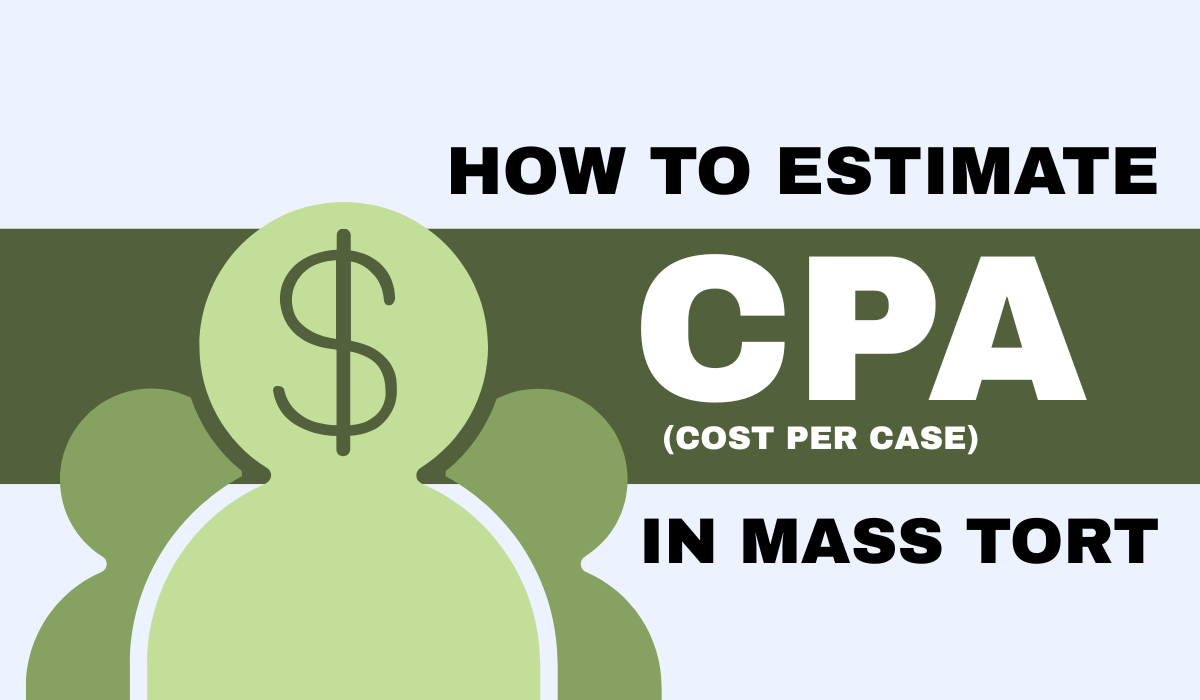Why Some Mass Torts Cost $300 Per Signed Case—And Others Reach $6,000+
Law firms often ask: “What will it cost to acquire a signed case?” But the more strategic question is: “What do we know about the audience, timing, market saturation, and intake criteria?”
The cost-per-acquisition (CPA) of a signed retainer is never static. It’s the result of five core drivers:
- The size and location of the exposed population
- The maturity of the tort (emerging vs. oversaturated)
- The fit between lead filters and intake criteria
- The level of market competition
- The channel strategy across Meta, TV, search, and more
At Blue Sky Legal, we use this framework to predict CPA with precision, then build campaigns to deliver signed retainers at a targeted price range.
1. Start with the Addressable Population—and Where It Lives
Every CPA model begins with the audience:
- How many people were exposed to the drug, product, or injury environment?
- How many developed the relevant injury or condition?
- Is it national—or limited by state?
If you’re only targeting four states—or excluding several states due to venue or statute issues—your cost per signed case can double. You’re narrowing the pool and bidding against the same firms for fewer leads.
We analyze:
- FDA reports and clinical studies
- Prescription and sales data
- Demographic patterns
- State-by-state exposure or eligibility
The narrower the geo + injury window, the higher your CPA will be.
2. Identify the Tort Phase
Where a tort sits in its lifecycle affects everything—from signing rate to ad saturation:
| Phase | Description | CPA Range |
| Emerging | Pre-MDL, low awareness, low competition | $300–$1,800 |
| Buzzy | Media spike, rising interest, more firms enter | $2,000–$4,000+ |
| MDL Stage | Established science, filters tighten, firms compete | $3,500–$5,500+ |
| Late | Claim saturation, statute nearing, limited signing window | $5,500–$6,500+ |
In early hernia mesh campaigns, signing rates were high when “product in place” was enough. But as the science matured, complications and revision surgery became must-haves—driving CPA higher.
By Q4 2023, Camp Lejeune was closing over $6,000 per signed case due to heavy competition, narrow injury criteria, and media fatigue.
3. Align Filters with What You’ll Actually Sign
Poor criteria alignment—not bad leads—is the #1 reason CPA spikes.
If your firm is only signing certain diagnoses, surgeries, or timelines, you need leads screened for those exact qualifiers.
Example: Early hernia mesh campaigns had 40–50% qualification rates—if the filter was just implant in place.
Example: Late-stage Camp Lejeune campaigns that only accepted three conditions saw 6–8% conversion. That may have been the right move for settlement strategy—but it meant much higher cost per case.
At Blue Sky Legal, we start with your intake criteria, then work backward to build media and filter logic that mirrors how your team qualifies cases. A typical average is 1 in 8 leads signing, but we’ve seen performance range from 1 in 2 to 1 in 20, based on filter strategy.
4. Measure the Market: Who Else Is Competing?
Even with perfect filters, competition drives price. We actively track:
- Facebook Ad Library – How many firms are running this tort?
- Google Trends – Is public search interest rising?
- Google Paid Search – Are other firms bidding on high-intent terms?
- TV & Radio – Are major firms running national spots?
- Affiliate/email traffic – Is there supply in-market?
If competition is light, CPA is low and test campaigns yield strong early returns.
If you’re entering when 50+ firms are bidding on Meta, and top 5 law firms are blanketing TV, expect your CPA to climb fast.
Blue Sky Legal constantly monitors these channels to guide media and pricing decisions.
5. Choose the Right Media Stack
Not all channels perform equally. We adapt based on audience, cost, and filter complexity:
Meta (Facebook/Instagram)
- Scalable for general PI-style cases
- CPA inflates with saturation
- Best for mid-tier filters and broad demographic reach
TikTok
- Good for buzzy or youth-adjacent torts
- Weak for medical complexity or older demos
- Works as an awareness layer, not primary intake
CTV (Connected TV)
- Strong when paired with household targeting or third-party health data
- Excellent for torts with emotional storytelling or geo-based exposure
- Higher CPM, but delivers quality when scaled right
TV & Radio
- Still vital for veterans, institutional abuse, or long-term exposure
- Slower feedback loop
- Best when digital channels max out
Google Search
- High intent, but expensive for saturated torts
- Crucial for branded firm terms and downstream conversion
- We monitor keyword bid activity before launching
We tailor media to the right audience at the right phase, ensuring we’re not wasting dollars on oversaturated tactics.
6. How We Model Your CPA
We don’t guess. We model based on:
- Population size and injury incidence
- Geographic constraints (national vs. state-specific)
- Phase of the tort
- Filter complexity and intake compatibility
- Media competition across digital and traditional channels
- Historical comparables
- Conversion baseline (1 in 8)
We typically test with 10–20 cases, then scale the mix once we’ve confirmed results.
Real Campaign Examples
Here’s how some of our current campaigns stack up:
Video Game Addiction
- Early-stage, little competition
- Over 400,000 addressable users
- Broad behavioral filters
- CPA range: $300–$1,200
Rideshare Sexual Assault (Uber/Lyft)
- MDL-stage
- Stricter filters: police reports, complaint window
- Moderate-to-high media saturation
- CPA range: $4,000+
Institutional Sexual Abuse (Church, Schools, Youth Orgs)
- Late-stage and highly oversaturated
- Limited geographic expansion left
- CPA range: $5,500–$6,500+
Depo-Provera Birth Control
- MDL-stage, science tightening
- Low addressable population for key injury (osteoporosis/fractures)
- CPA range: $3,500–$5,500, depending on filters
What We Deliver
We’re not in the lead business. We deliver signed retainers at a targeted price range, backed by:
- End-to-end media buying (Meta, TV, Search, CTV, Email, TikTok)
- Intake via human-assisted + AI-enhanced platform
- Filter alignment based on your criteria
- Full packet delivery: retainer, HIPAA, HITECH, injury/eligibility checklist
Talk with us to model your next tort. If it’s viable, we’ll show you how to hit your numbers. If not, we’ll be the first to say so.


